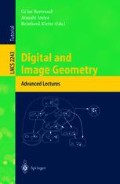Abstract
The 1-D Leap-Frog Algorithm [12] is an iterative scheme for solving a class of nonlinear optimization problems. In the present paper1 we adapt Leap-Frog to solve an optimization problem in computer vision. The vision problem in the present paper is to recover (as far as possible) an integrable vector field (over an orthogonal grid) from a field corrupted by noise or the effects of digitization of camera images. More generally, we are dealing with integration of discrete vector fields, where every vector represents a surface normal at a grid position within a regular orthogonal grid of size N × N. Our 2-D extension of Leap-Frog is a scheme which we prove converges linearly to the optimal estimate. 1-D Leap-Frog [12] can deal with nonlinear problems such as are encountered in computer vision. In the present paper we exploit Leap-Frog’s capacity to handle large number of variables for a linear problem (in this situation Leap-Frog becomes an extension of Gauss-Seidel), and we offer a geometrical proof of convergence for the case of photometric stereo (see e.g. [10],[11]), where data is corrupted by noise or digitization. In the present paper, noise enters in an especially simple way, as Gaussian noise added to gradient estimates. So this as a first step towards more realistic (and demanding) applications, where Leap-Frog’s capacity to deal with nonlinearities is needed. The present paper also offers an alternative to other methods in photometric stereo [3], [6], [13], and [15]. The performance of 2-D Leap- Frog was demonstrated in [14] without proof of convergence: established methods are faster, but without Leap-Frog’s capacity for generalization to nonlinear problems.
This research was supported by an Australian Research Council Small Granta,b and an Alexander von Humboldt Research Fellowship.b
Access this chapter
Tax calculation will be finalised at checkout
Purchases are for personal use only
Preview
Unable to display preview. Download preview PDF.
References
Benzi M., Nabben R., Szyld D. (2000) Algebraic theory of multiplicative Schwarz methods. Tech. Report 00210 Dep. Math., Temple Uni., Pliladelphia, USA, http://www.math.temple.edu/~szyld/. Numerische Mathematik. In press
Buzbee B. L., Golub G. H., Nielson C. W. (1970) On direct methods for solving Poisson’s equations. SIAM J. Numer. Anal. 7, (4):627–656
Frankot R. T. Chellappa R. (1988) A method of enforcing integrability in shape from shading algorithms. IEEE 10, (4):439–451
Hackbush W. (1994) Iterative Solution of Large Sparse Systems of Equations. Springer, New York, Heidelberg, Berlin
Horn, B. K. P. (1986) Robot Vision. McGraw-Hill, New York Cambridge, MA
Horn B. K. P. (1990) Height and gradient from shading. Int. J. Comp. Vision 5, (1):37–75
Horn B. K. P., Brooks M. J. (1989) Shape from Shading. MIT Press, Cambridge, MA
Kaya C. Y., Noakes L. (1998) A Leap-Frog Algorithm and optimal control: theoretical aspects. In: Caccetta L., Teo K. L., Siew P. F., Leung Y. H., Jennings L. S., Rehbock V. (Eds) Proc. 2nd Int. Con. Optim. Tech. Appl., Perth, Australia, July 1–July 3 1998. Curtin Uni. of Technology, 843–850
Klette R., Schlüns K. R., Koschan A. (1998) Computer Vision-Three Dimensional Data from Images. Springer, Singapore
Kozera, R. (1991) Existence and uniqueness in photometric stereo. Appl. Math. Comput. 44, (1):1–104
Kozera R. (1992) On shape recovery from two shading patterns. Int. J. Patt. Rec. Art. Int. 6, (4):673–698
Noakes L. (1999) A global algorithm for geodesics. J. Math. Australian Soc. Series A. 64, 37–50
Noakes L., Kozera R., Klette R. (1999) The Lawn-Mowing Algorithm for noisy gradient vector fields. In: Latecki L. J., Melter R. A., Mount D. M., Wu A. Y. (Eds) Proceedings of SPIE Conference, Vision Geometry VIII, Denver, USA, July 19–July 20 1999. The International Society for Optical Engineering, 3811:305–316
Noakes L., Kozera R. (1999) A 2-D Leap-Frog Algorithm for optimal surface reconstruction. In: Latecki L. J., Melter R. A., Mount D. M., Wu A. Y. (Eds) Proceedings of SPIE Conference, Vision Geometry VIII, Denver, USA, July 19–July 20 1999. The International Society for Optical Engineering, 3811:317–328
Simchony T., Chellappa R., Shao M. (1990) Direct analytical methods for solving Poisson equations in computer vision problems. IEEE Trans. Patttern Rec. Machine Intell. 12, (5):435–446
Author information
Authors and Affiliations
Editor information
Editors and Affiliations
Rights and permissions
Copyright information
© 2001 Springer-Verlag Berlin Heidelberg
About this chapter
Cite this chapter
Noakes, L., Kozera, R. (2001). The 2-D Leap-Frog: Integrability, Noise, and Digitization. In: Bertrand, G., Imiya, A., Klette, R. (eds) Digital and Image Geometry. Lecture Notes in Computer Science, vol 2243. Springer, Berlin, Heidelberg. https://doi.org/10.1007/3-540-45576-0_21
Download citation
DOI: https://doi.org/10.1007/3-540-45576-0_21
Published:
Publisher Name: Springer, Berlin, Heidelberg
Print ISBN: 978-3-540-43079-7
Online ISBN: 978-3-540-45576-9
eBook Packages: Springer Book Archive

